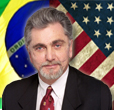by Moses Apsan
May 1, 2010 - Amateur Astronomer Jim Sofia was setting up his fine 18 inch Obsession Ultra Compact dobsonian telescope when he wondered if he could avoid moving back and forth, from the back of the primary mirror to the location of the focuser, to collimate his primary mirror. He seemed to be getting a bit too impatient with this process and could not wait to begin stargazing! Then he had “Eureka moment” thinking: “Why not manipulate the turning of the collimation knobs by remote control!"
Jim Sofia found a way to eliminate the need to have one person turn the collimation knobs in back of the primary while the other assess collimation accuracy at the location of the focuser (independence). The invention also eliminates the need for one person to shift back and forth from the back of the primary mirror to the eye level location of the focuser during the collimation process (convenience). It optimizes collimation precision because the collimation knob turns in gradations of speed depending on the pressure exerted on the transmitter joystick. After practice, PCA takes less than a minute to set up in the field.
Jornal.us interviewed amateur astronomer inventor, Jim Sofia:
Jornal.us: So how does Primary Collimation Assist (PCA) help the user?
Jim: PCA was designed to remotely control the turning of each of 3 collimation knobs of the primary mirror on large Dobsonian telescopes, like the fine Obsession models, so you can be at a distance away, at the location of the focuser, to assess the task. In large telescope models the distance can be between 6 and 12 feet which would require the person to go back and forth, depend on a buddy or look at an image from an angle some distance away.
Jornal.us: Why is primary collimation necessary?
Jim: When the optical axis of the primary mirror, secondary mirror and focuser eyepiece are brought into precise alignment, your image is clear and optimized. The advantage of a large dobsonian telescope of good quality optics, like the Obsession models, is that its large primary mirror collects much light and a clear bright image can be magnified to show a crisp, magnificent and breathtaking sight!
Jornal.us: Is the collimation of the primary mirror of a dobsonian telescope a difficult task?
Jim: No, not really. Whether you use PCA or not, it is pretty straightforward. PCA just makes the task more convenient and fun, in my opinion. It is as easy as turning a joystick from a ringside seat!
Jornal.us: So how does one collimate the primary mirror of a dobsonian telescope? What collimation tools are used?
Jim: Well for example, the cheshire collimation eyepiece is a popular method. It is inserted in the focuser tube and gives you a visual picture of the position and alignment of the focuser, secondary and primary mirrors relative to each other. Once the focuser is square and the secondary mirror is properly collimated, one usually only needs to collimate the primary mirror after the scope is set up. The cheshire shows you the center of the primary mirror, which is marked with a black circle affixed to the glass. The tilt of the primary often needs to be adjusted by turning the collimation knobs in back of it which are some distance away, so as to place the center ring of the primary you see through the cheshire eyepiece in the center of the visual image on the secondary, forming a nice concentric circular pattern. As the collimation knobs move, so does the primary mirror center ring move. You don’t need to be in two places at once with PCA! You can collimate from one location, looking directly through the cheshire.
The barlowed laser is another collimation tool that is placed in the focuser tube and shines a diffuse light onto the primary which reflects its center ring image back onto the focuser drawtube. Turning the collimation knobs visually centers the ring in the tube. The optical axis of the primary mirror and the optical axis of the eyepiece seen through the focuser onto the secondary are brought into precise alignment. Again, you can observe the ring image at the location of the focuser and remotely turn the collimation knobs in back of the primary mirror, which are at some distance away, to perform the task.
Jornal.us : Does the size of the telescope make PCA more convenient to use?
Jim: Yes it does. With a smaller scope the distance between the focuser and primary mirror is shorter.
Jornal.us: What about set-up time for PCA?
Jim: ((With a bit of practice PCA sets up in the field in about half a minute)). You are then using your collimation tool of preference, and there are several others I have not mentioned, to assess collimation accuracy by the precise remote control turning of the collimations knobs.
Jornal.us: How does one learn more about PCA?
Jim: Visit www.primarycollimationassist.com.
More about Jim Sofia: Dr. Jim Sofia is the Chief Psychologist for a major school board in Ontario Canada. He received his doctorate at the University of California, at Berkeley in the late seventies. While he does practice school psychology, he also has an avid interest in astronomy. The great wonders of the heavens and evolution of the universe has been of great interest to him. One clear and beautiful evening a few years ago he beheld the crescent moon conjunct with one of the planets and thought, "wouldn't it be great to see this through a telescope!" Before long he purchased his first 8 inch schmidt assigrain Celestron telescope and graduated to a 12 inch Obsession dobsonian and presently to an 18 inch Obsession Ultra Compact dobsonian. With an appreciation in fine optics, Jim observes the heavens from the northern latitude of Ontario Canada and belongs to astronomy groups including the Royal Astronomical Association of Canada and the Ottawa Valley Astronomy and Observers Group.

